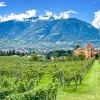You might think of coffee as just a hot beverage you drink from a paper cup in the car on the way to work. Here in Italy, coffee is not simply a drink, it's a key aspect of the culture. It's a social event and a tradition that Italians proudly preserve. In Italy, we don't have coffee chains (although Starbucks tried to open here!), but instead have coffee bars. Bars mark nearly every corner in Italian cities, and it is not uncommon to find four of them, one right after the other, on the same road. Usually family-owned and run, some bars have decades or even centuries of history. They're generally pretty small--finding a bar with more than five or eight tables is rare--and each one has its own personality and design. All of them have two key items: the bar counter and an espresso machine standing behind it.
You'll likely never ever see an Italian walking with a coffee cup in hand or jumping on an underground train with one. Everything coffee-related takes place within the walls of a coffee establishment. In most cases, a person enters a bar, orders their coffee, drinks it standing at counter, pays (afterwards!) and leaves. The time required to perform this sequence of actions is approximately one minute. This may come as a shock to Americans, but in Italy we don't have size options. No grande, no tall, no enormous vat. All coffee beverages have standard sizes and huge volumes simply do not exist. If you find yourself looking for a pick-me-up in Italy, here are some helpful tips on what--and when--to order:
Espresso: Forget about Frappuccinos, chai tea lattes or any other sugar-filled drinks. Italians drink espresso. If you want to order one, just say "un caffé per favore." For us, espresso is coffee; the two terms are completely interchangeable. An espresso is bitter and intense and comes in a heated white ceramic cup--we call it a tazzina. No paper cups, no plastic lids, no wooden stir sticks. An Italian coffee always comes with a small ceramic plate and a silver spoon.
Caffé Americano: We don't have standard American drip coffee in Italy. Instead there's something called caffè Americano, but it's rare to find places with that kind of coffee machine. You can try to ask for one, but it's possible the barman will look at you like you came from the moon.
Macchiato: If an espresso tastes too strong for you, ask for a macchiato: it's a simple espresso with enough milk to fill the small tazzina. You can have a macchiato anytime you want during the day: in the morning, after dinner or even during the afternoon.
Cappuccino: The enlarged version of macchiato is called cappuccino, and it's the most beloved coffee among visitors to Italy. It comes in a bigger cup with foamed milk. Now let's talk about something important: it's practically against the law to have cappuccino if it's not your entire breakfast! It's advised to never order a cappuccino following lunch or dinner, or--even worse--during your meal.
Latte: Jonesing for a latte? Go ahead and order it anytime you wish! But you might be surprised when you're given a plain glass of milk. Latte means milk in Italian, and if you ask for one, be prepared to answer the barman's question: "Caldo o freddo?" (Warm or cold?).
Affogato al caffé: If you're in search of dessert, ask for affogato al caffé, which is ice cream drowning in a shot of hot espresso (affogare means "to drown"). You can also order it as a merenda (snack). Some places serve it con panna (with whipped cream).
Caffè shakerato: Another coffee drink you can order mid-morning or in the afternoon is caffè shakerato, a very refreshing drink often served in a champagne glass. An espresso shot shaken with ice and sugar then strained, it's the perfect drink to sip on a sunny café terrace in a lively piazza. There's a proverb that says "When in Rome, do as the Romans do." When it comes to drinking coffee, you now have a guide to help you do as the Italians do!








